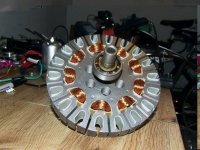Karma graciously rewound this old 1980s cieling fan motor stator for me,
View attachment 11
View attachment 10
and it just arrived back here fully wound, terminated in Wye (for now, at least):
View attachment 9
Now I just need to find lots of magnets I can use for it, if anyone has some off an old hub motor core or two.
Here's it with it's original casing and AC-style flux ring

with a disk rotor on the ring for comparison
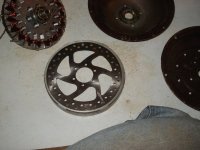
and with the parts stacked
View attachment 6
and showing the casing held together in it's original shape
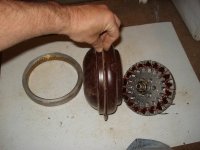
A couple years or more ago, I originally tested the basic idea of converting a Hampton Bay fan motor

by cutting the stator winds apart from each other, wiring them up in ABCABCABC

and hooking them to a laser printer's scanner-mirror controller,
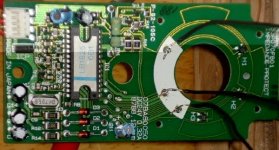
powered off a little SLA battery.
http://electricle.blogspot.com/2007/12/bldc-motor-test-proof-of-concept-with.html
As the halls were mounted on the controller board and not in the proper place for the phases on the motor, it wouldn't self start or run well, but it did work, and encouraged me to want to fully convert the motor.
There is a short video of it working at the bottom of that post, copied here for ease of viewing:
[youtube]RhngvMM7fRk[/youtube]
I just used a few (mismatched) harddisk magnets placed (unevenly) around the outside of the motor casing. I'm sure it'd've worked a lot better if I had had the flux ring there with magnets embedded in it and a smaller air gap.
However, harddisk magnets are magnetized in the wrong direction, and shaped the wrong way, to be useful for this kind and shape of motor. I quested for a while to find the magnets for it, and at the time IIRC it'd've cost me about $500 to get them. Much more for custom-shaped versions that would fit the curve of the ring and/or be trapezoidal to give better anti-cogging results. That wasn't worth it by any measure, especially for an experiment that might not even result in a useful motor. At the time I had heard of hub motors but not yet even seen one in person other than in passing on a bike somewhere, I think, or I would have started looking for some of those to rebuild or use instead of trying this project. Or at least to use for magnets.
That's the biggest thing stopping me from trying this out now (well, soon, as I have other stuff I must first finish)--magnets. I haven't ever found a good source for a bunch of identical ones that can be used for this.
If you look at the AC-type induction ring, you'll see the lamination inserts are trapezoidal to reduce cogging. That's how I wanted to use the magnets, too.

I was thinking at the time that I could probably setup this motor as a hub motor in a wheel, if I rebuilt the casing to support spokes, but that most likely I'd use it as a mid-drive, much as first the treadmill motor and later the powerchair motors were, on CrazyBike2.
I'd expected to bolt the sprocket to the old fanblade mounting points, as they were already threaded, or drill new ones for smaller sprockets. Or I would cut the threaded side of a rear hub off, and bolt that to the casing on the left side, using it to house a freewheeling cassette, perhaps, if I found a way to keep it from coming unscrewed under power. (at the time I did not know about lefty freewheels).
The experiment might also have worked better if I had tried it with the outer windings instead, but I had already unwound them partway before I even thought of it:
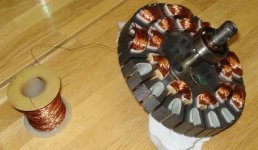
View attachment 11
View attachment 10
and it just arrived back here fully wound, terminated in Wye (for now, at least):
View attachment 9
Now I just need to find lots of magnets I can use for it, if anyone has some off an old hub motor core or two.
Here's it with it's original casing and AC-style flux ring

with a disk rotor on the ring for comparison

and with the parts stacked
View attachment 6
and showing the casing held together in it's original shape

A couple years or more ago, I originally tested the basic idea of converting a Hampton Bay fan motor

by cutting the stator winds apart from each other, wiring them up in ABCABCABC

and hooking them to a laser printer's scanner-mirror controller,

powered off a little SLA battery.
http://electricle.blogspot.com/2007/12/bldc-motor-test-proof-of-concept-with.html
As the halls were mounted on the controller board and not in the proper place for the phases on the motor, it wouldn't self start or run well, but it did work, and encouraged me to want to fully convert the motor.
There is a short video of it working at the bottom of that post, copied here for ease of viewing:
[youtube]RhngvMM7fRk[/youtube]
I just used a few (mismatched) harddisk magnets placed (unevenly) around the outside of the motor casing. I'm sure it'd've worked a lot better if I had had the flux ring there with magnets embedded in it and a smaller air gap.
However, harddisk magnets are magnetized in the wrong direction, and shaped the wrong way, to be useful for this kind and shape of motor. I quested for a while to find the magnets for it, and at the time IIRC it'd've cost me about $500 to get them. Much more for custom-shaped versions that would fit the curve of the ring and/or be trapezoidal to give better anti-cogging results. That wasn't worth it by any measure, especially for an experiment that might not even result in a useful motor. At the time I had heard of hub motors but not yet even seen one in person other than in passing on a bike somewhere, I think, or I would have started looking for some of those to rebuild or use instead of trying this project. Or at least to use for magnets.
That's the biggest thing stopping me from trying this out now (well, soon, as I have other stuff I must first finish)--magnets. I haven't ever found a good source for a bunch of identical ones that can be used for this.
If you look at the AC-type induction ring, you'll see the lamination inserts are trapezoidal to reduce cogging. That's how I wanted to use the magnets, too.

I was thinking at the time that I could probably setup this motor as a hub motor in a wheel, if I rebuilt the casing to support spokes, but that most likely I'd use it as a mid-drive, much as first the treadmill motor and later the powerchair motors were, on CrazyBike2.
I'd expected to bolt the sprocket to the old fanblade mounting points, as they were already threaded, or drill new ones for smaller sprockets. Or I would cut the threaded side of a rear hub off, and bolt that to the casing on the left side, using it to house a freewheeling cassette, perhaps, if I found a way to keep it from coming unscrewed under power. (at the time I did not know about lefty freewheels).
The experiment might also have worked better if I had tried it with the outer windings instead, but I had already unwound them partway before I even thought of it:



